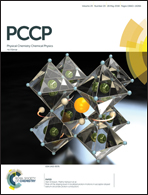Tuning the adsorption and interaction of CO and O2 on graphene-like BC3-supported non-noble metal atoms†
Abstract
Research into suitable substrate-supported single-atom catalysts has become a major challenge for electrochemical sensors and energy devices. Firstly, we investigate the adsorption properties of metal atoms (MA = Fe, Co, Ni, Cu and Al) on pristine and defective BC3 sheets through using first-principles calculations. It is found that the MA-doped BC3 configurations (MA-BC3) are quite stable at high temperature and the positively charged MAs as surface active sites can effectively regulate the stability of reactive gases. Secondly, the adsorption of individual O2 molecules is more stable than that of CO molecules, which can modify the electronic and magnetic properties of MA-BC3 systems. Moreover, the possible reaction processes of CO oxidation on the Fe-BC3 substrate are comparably analyzed through the Eley–Rideal (ER) and Langmuir–Hinshelwood (LH) mechanisms. In the LH mechanism, the coadsorbed O2 and CO as starting materials start to form an OOCO complex with a smaller energy barrier (0.38 eV), which is an energetically more favorable process than that of the OOCO (0.65 eV) or CO3 complex (0.42 eV) formed through ER mechanisms. This result indicates that the functionalized MA-BC3 sheets have low cost and high activity.



 Please wait while we load your content...
Please wait while we load your content...